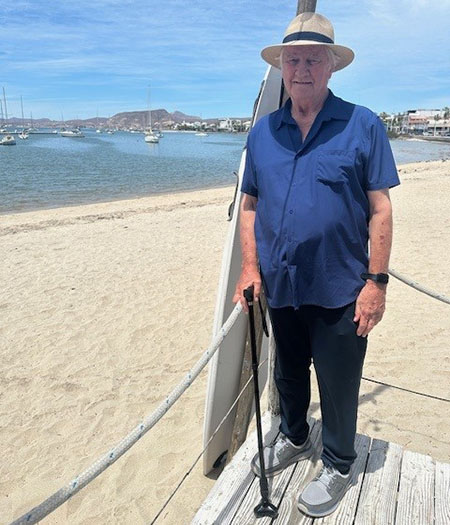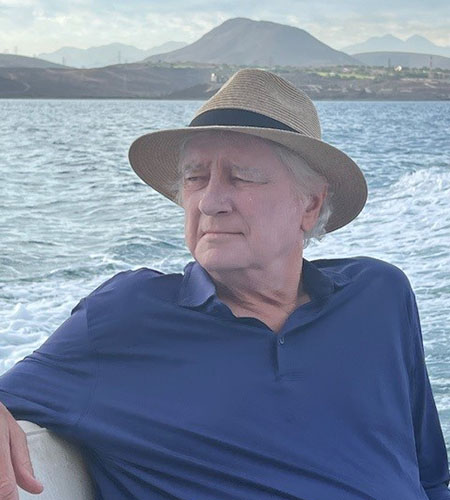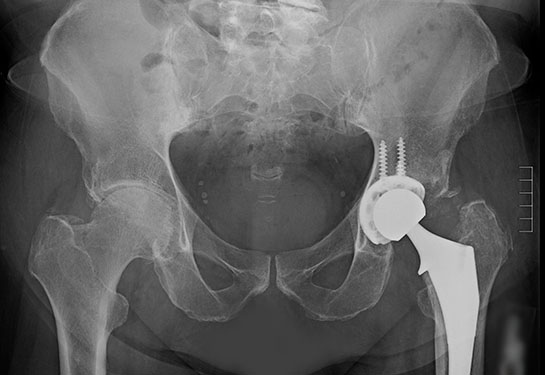‘It’s been a life changer’: Complex hip replacement surgery allows doctor to walk upright again
When Michael McGrath’s recovery room nurse helped him stand after his hip surgery at UC Davis Health in late December 2024, they were both surprised.

“She looked up at me and said, ‘Oh my gosh, you’re so tall!’ And I was shocked my left hip actually held my weight. That was the first time I’d stood up straight in a long time,” he recounted.
McGrath, a professor in the UC San Francisco School of Medicine, had entered the hospital that day using a walker and wheelchair. A prior surgery to relieve unrelenting hip pain had left his femur — the large thigh bone —disconnected from his left hip joint, which slumped downward with every other step. Hunched over his walker, he had appeared far shorter than his height of 6’2”.
The day of his hip replacement, performed by orthopaedic surgeon Adam J. Taylor, was the first day he had walked upright since 2023.
By January 2025, McGrath was able to stand and lecture at a conference on his pioneering work developing a drug to treat amyotrophic lateral sclerosis (ALS), also known as Lou Gehrig’s disease. In April, he golfed for the first time in three years. In May, he traveled with his family to Mexico and enjoyed fishing in the Sea of Cortez.

“Being able to do simple things like walk and go to meetings and travel has been so huge for me,” McGrath said. “It’s been life changing.”
Weighing the risks of a complicated medical history
McGrath’s surgery followed years of illnesses and injuries. An accidental cut to an artery during a 2020 surgery damaged his lymphatic system, swelling his legs and limiting his mobility. By the end of 2021, he had developed tremendous hip pain and sought a surgeon to repair the joint. However, damage to his aortic artery in 2022 and a high risk of infection due to previous illnesses left him temporarily ineligible for hip replacement surgery.
Instead, the head of his thigh bone, which fits into the hip socket, was removed in 2023 to relieve the pain. The surgery left his left femur four inches shorter than his right, and he was unable to get around without a walker or wheelchair.
After recovering from a long battle with pneumonia in 2024, McGrath continued to search for a surgeon to restore his mobility. In December 2024, he approached Taylor about the possibility of hip replacement surgery.
It was a higher-risk surgery due to his medical and surgical history, but he also had significant functional limitations. We made a shared decision to go ahead, and he’s been doing wonderfully.”—Adam Taylor, assistant professor of clinical orthopaedic surgery
Taylor was hesitant about the risk of a life-threatening infection or other medical complications, but McGrath insisted regaining his mobility was worth the risk. After consulting with some of McGrath’s health providers, Taylor agreed to perform the surgery.
“It was a higher-risk surgery due to his medical and surgical history, but he also had significant functional limitations,” Taylor explained. “We made a shared decision to go ahead, and he’s been doing wonderfully.”
While the majority of Taylor’s surgical practice consists of routine hip and knee replacements, he estimates that 25% of his cases are revisions of prior surgeries, like the procedure on McGrath’s femur.
To repair the truncated thigh bone, Taylor inserted a titanium stem, capped with a ball to fit into the hip socket into the end of the femur. A porous layer of the mineral hydroxyapatite, naturally found in bone and teeth, coated the titanium alloy. This allowed bone to grow into the implant and strengthen the repair. He also reconstructed the pelvis with the same titanium material and paired the implants together. Now, McGrath can walk comfortably.

McGrath described Taylor as a “thoughtful” surgeon: “He ordered tests that showed he was considering my complicated medical history. I could tell he gave my situation a lot of thought, and he’s a credit to the surgical group at UC Davis.”
McGrath’s timeline for recovery will be longer than most patients. But Taylor is optimistic he’ll regain more of his lost mobility.
“As doctors, we all strive to help patients so they can help other people, and Dr. McGrath is a great example,” Taylor said. “Now, he’s back at work performing cutting-edge research on Alzheimer’s disease and ALS. Helping him regain hip functionality has been very satisfying.”
Learn how to make an appointment with orthopaedic surgery at UC Davis Health.





